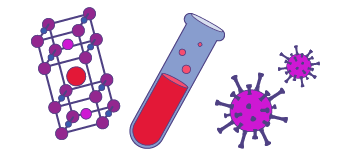Performing broad-band optical spectroscopy in our ultrahigh field pulsed magnets is a mainstay of our optics program at the Pulsed Field Facility.
To date we have studied a variety of material systems, including bulk semiconductors and quantum wells, epitaxial quantum dots and colloidal nanocrystals, carbon nanotubes and quantum wires, complex oxides, and quantum spin ladder compounds.
Polarization-resolved optical studies can often be used as a proxy for direct magnetization measurements. In particular, magneto-optical effects such as magnetic circular dichroism (MCD) and optical Faraday rotation (FR) depend explicitly on breaking of time-reversal symmetry. Typically this means the presence of magnetization. We often use MCD and FR to infer and study magnetization in materials ranging from semiconductors to colloidal quantum dots to complex oxides to organic molecules (see references below). Often the sensitivity exceeds that of conventional (eg, SQUID) magnetometry, and moreover the detailed spectral dependence of the signal can pinpoint specific mechanisms and energy scales.
Detectors and Spectrometers:
Sources:

Explore our magnet schedule to see what exciting research is happening on our stellar fleet of instruments right now.
W.D. Rice, et al, Persistent optically induced magnetization in oxygen-deficient strontium titanate, Nat. Mater. 13 (2014) Read online.
K. Alberi, et al, Magnetic-field induced delocalized to localized transformation in GaAs:N, Phys. Rev. Lett. 110 (2013) Read online.
L. G. Booshehri, et al, Circular polarization dependent cyclotron resonance in large-area graphene in ultrahigh magnetic fields, Phys. Rev. B 85 (2012) Read online.
T. Greidig, et al, Substrate-controlled ferromagnetism in iron phthalocyanine films due to one-dimensional iron chains, Phys. Rev. B 86 (2012) Read online.
A. Pandley, et al, Long-lived photo-induced magnetization in copper-doped ZnSe/CdSe core/shell nanocrystals, Nat. Nanotechnol. 7 (2012) Read online.
D.A. Bussian, et al, Tunable magnetic exchange interactions in Mn-doped inverted core-shell ZnSe/CdSe nanocrystals, Nat. Mater. 8 (2009) Read online.
J. Shaver, et al, Magneto-optical spectroscopy of highly-aligned carbon nanotubes: Identifying the role of threading magnetic flux, Phys. Rev. B Rapid-Comm 78 (2008) Read online.
S.A. Crooker, et al, Tuning alloy disorder in diluted magnetic semiconductors in high fields to 89 tesla, Appl. Phys. Lett. 90 (2007) Read online.
S. Zaric, et al, Excitons in carbon nanotubes with broken time-reversal symmetry, Phys. Rev. Lett. 96 (2006) Read online.
Last modified on 01 August 2023